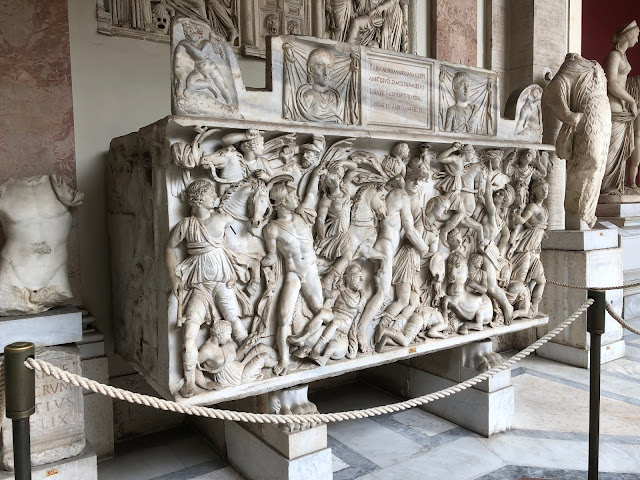【ローマ】ヴァチカン ピオ・クレメンティーノ美術館① Roma - Musei Vaticani, Museo Poi-Clementino Part-1
ヴァチカン美術館と呼ばれているこの美術館の中は、さらに小さないくつかの美術館から構成されている。
その全てをゆっくりと見て回るのは、1日ではほぼ不可能だ。
そこで、多くの観光客は、有名なシスティーナ礼拝堂やラファエロの間などの限られた場所だけを見ることになる。
この古代彫刻が展示されているピオ・クレメンティーノ美術館も、そうした人気のコースの一つ。
そのせいか、館内はものすごい数の人で溢れていて、日本の東京駅や新宿駅の朝のラッシュアワーのような様相を呈していた。
The museum, called the Vatican Museums, consists of several smaller museums.
It's almost impossible in a day to look around all of them slowly.
There, many tourists will only see limited places such as the famous Sistine Chapel and Raphael Rooms.
The Pio Clementino Museum, where this ancient sculpture is on display, is one such popular course.
Probably because of that, the hall was full of people, and it looked like the morning rush hour at Tokyo Station and Shinjuku Station in Japan.
有名なラオコーン像もオリジナルは紀元前2世紀に古代ギリシャで作られたものだが、これは1世紀に古代ローマで作られたもの。
コピー作品といっても、オリジナルに忠実に作られていて、見る者を圧倒する迫力を持っている。
現代から見たら、およそ2000年前に作られた彫刻で、コピーでもよくぞ現在まで残ってくれたと感心してしまう。
The famous Laocoon statue was originally made in ancient Greece in the 2nd century BC, but it was made in ancient Rome in the 1st century.
Even though it is a copy work, it is made faithfully to the original and has the power to overwhelm the viewer.
Seen from the present day, it is a sculpture made about 2000 years ago, and I am impressed that it has remained until now even if it is a copy.
オリジナルは紀元前4世紀に作られて、それを元に2世紀に古代ローマで製作された、”ベルヴェデーレのヘルメス像”。
18世紀に活躍したドイツ人の美術史家であるヴィンケルマンは、ドレスデンで古代美術の魅力に触れて、その後はローマに移住して研究を続けた。
ヴィンケルマンは、芸術とは自然を理想化して表すべきもので、それは古代ギリシャの時代に完成したと考えて、全ての芸術はそれを模倣すべきだと考えていた。
ヴィンケルマンの思想は、同時代のゲーテやレッシングにも影響を与えて、18世紀の新古典主義の理論的な支柱になった。
The original was made in the 4th century BC, and based on it, it was made in ancient Rome in the 2nd century, "Hermes statue of Belvedere".
Winckelmann, a German art historian who was active in the 18th century, came into contact with the charm of ancient art in Dresden and then moved to Rome to continue his studies.
Winckelmann thought that art should be an idealization of nature, which was completed in the time of ancient Greece, and that all art should imitate it.
Winckelmann's ideas also influenced his contemporary Goethe and Lessing and became a theoretical pillar of neoclassicalism in the 18th century.
そのゲーテも、イタリア旅行の際に、この場所を訪れていた。
当時は、現代のような照明器具がなかったせいか、松明を炊いてこうした彫像を細く鑑賞するこということが行われていたようだ。
『イタリア紀行』によれば、ゲーテは、通常に光だけでは見えないラオコーン像の細部を見れたことに満足していたようだ。
Goethe also visited this place during his trip to Italy.
At that time, it seems that it was practiced to cook torches and appreciate these statues in detail, probably because there were no lighting fixtures like in modern times.
According to Italienische Reise, Goethe was pleased to see the details of the Laocoon statue, which is normally invisible to light alone.
円形の間、と呼ばれれる部屋には、壁ぞいにぐるりと立像が置かれている。
その中央部分には、巨大なブロンズのヘラクレス像が来場者を見下ろしている。
紀元前4世紀のオリジナルをもとに、2世紀ごろに作られたと考えられている。
ブロンズ像は、鉄が不足した時代に素材として使われてしまったものが多く、こうして残っているのは珍しい。
In a room called "Circular Room", statues are placed all around the wall.
In the center, a huge bronze statue of Hercules looks down on the visitors.
It is believed to have been made around the 2nd century based on the original 4th century BC.
Many bronze statues were used as materials in the days when iron was scarce, and it is rare that they remain in this way.
円形の間の隣の、ムーセたちの間の中央に展示されている”ベルヴェデーレのトルソ”。









コメント
コメントを投稿